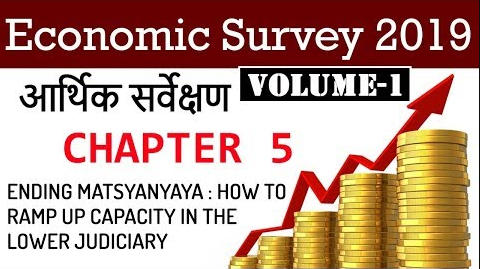Table of Contents

INTRODUCTION
- The Preamble to the Constitution of India defines that the first role of the State is ‘to secure for all its citizens: Justice, social, economic, and political’.
- In other words, economic success and prosperity are closely linked to the ability to enforce contracts and resolve disputes.
- In spite of introducing IBC & GST, India continues to lag on the indicator for enforcing contracts, climbing only one rank from 164 to 163 in the latest report of EODB, 2018.

- This is ironical for a country that has long idealized contract enforcement.
- As Tulsi Ramayana puts it, “praan jayi par vachan na jayi” i.e., “one’s promise is worth more than one’s life”.

- The Indian judicial system has over 3.53 crore pending cases.
- At first glance, this number looks very large and insurmountable, but this Chapter will argue it is a potentially solvable problem.
- Indeed, given the potential benefits, this may be the best investment that the Indian economy can make.

PENDENCY OF CASES IN D&S COURTS
- Distribution of pendency of both civil and criminal cases is more or less the same.
- More than 64% of all cases are pending for more than one year.

.
DISPOSAL OF CASES IN D&S COURTS
- Disposal time is measured as the time span between the date of filing and the date when the decision is passed.
- 74.7% of the civil cases and 86.5% of the criminal cases are disposed within 3 years.


INTERNATIONAL COMPARISON OF DISPOSAL RATE
- The average disposal time for civil and criminal cases in Indian D&S courts in 2018 was 4.4 fold and 6 fold higher respectively when compared with the average of Council of Europe members (2016).

CASE CLEARANCE RATE
- The Case Clearance Rate (CCR) is the ratio of the number of cases disposed of in a given year to the number of cases instituted in that year, expressed as a percentage.
- It is mainly used to understand the efficiency of the system in proportion to the inflow of cases.


HOW TO CLEAR THE LEGAL LOGJAM?
2 key issues:-
- Firstly, achieve 100% clearance rate so that there is zero accumulation to the existing pendency.
- Secondly, the backlog of cases already present in the system must be removed.
- Thus the solution is to appoint the additional JUDGES.



- The main point of this analysis is that a major hurdle to economic growth and social well-being can be stabilized through a relatively small investment in the legal system.
COMPARISON BETWEEN CIVIL & CRIMINAL CASES
- The civil cases contribute a mere 28.38% of total pendency while criminal cases contribute about 71.62% in D&S courts.
- CCR for all civil and criminal cases in D&S courts for 2018 was 94.76% and 87.41% respectively.
- Thus the additional judges must be specialized in particular criminal cases so as to speed up the disposal of such cases.
- Note that it is not merely for additional judges and legal reforms, but also police reforms.

- ‘Motor Vehicle’ and ‘Land Reference’ case types have done quite well, maintaining a CCR of 107.58% and 192.66% respectively in 2018.
- These areas need to maintain the current pace.

- Some people may take the view that the relatively poor performance of the criminal justice system is of no direct consequence to the economy.
- However, a behavioural approach would make no distinction since human beings are seen to respond to the overall context.

STATE-WISE CCR


HOW TO MAKE INDIAN COURTS MORE PRODUCTIVE?
Increasing work hours
- The Supreme Court works for 193 days, high courts 210 days and trial courts 245 days a year.
- In contrast, in the United States, courts never close for summer break, just as in some European countries, such as France.
- The Supreme Court of Canada goes on vacation for just 11 days. In Britain, the court closes for 24 days in a year.
Establishment of Indian Courts and Tribunal Services:-
- A major problem lies with the quality of the administration of the courts system, particularly backend functions and processes.
- Create a specialized service called Indian Courts and Tribunal Services (ICTS)–
(i)Provide administrative support functions needed by the judiciary.
(ii)Identify process inefficiencies and advise the judiciary on legal reforms.
(iii)Implement the process re-engineering.
Deployment of Technology:-
- One major effort in this direction is the e-Courts Mission Mode Project that is being rolled out in phases by the Ministry of Law and Justice.
- This has allowed the creation of the National Judicial Data Grid (NJDG).
- It had helped the stake-holders to keep track of individual cases and their evolving status.
- Most of the analysis in this chapter has been made possible by real time data made publicly available on the NJDG and e-Courts portals.
CONCLUSION
- It is difficult to predict the exact improvement.
- The required efficiency gains for clearing the backlog are ambitious but achievable if combined with speeding up appointments.
- Given the social and economic importance of this issue, it should be given top priority by policy-makers.

Latest Burning Issues | Free PDF























 WhatsApp
WhatsApp